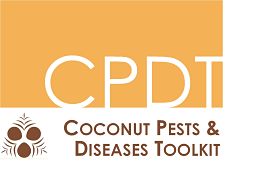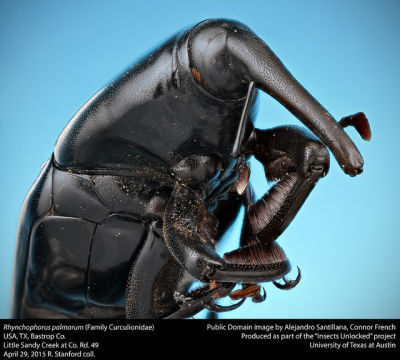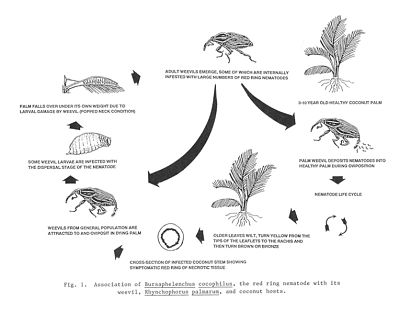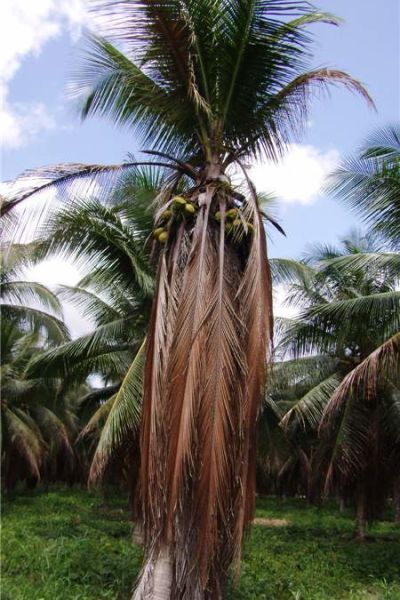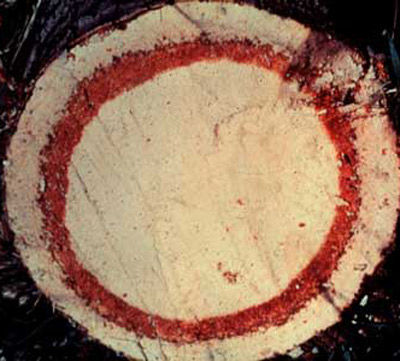Red ring disease
The red ring nematode causes lethal red ring disease in coconut palms. This is a HIGH risk due to it's impacts, but is not found in the Pacific. Biosecurity is important to prevent the entry of this pest as potential new vector insects are found in the Pacific (i.e. palm weevil).
Common name of the diseaseRed ring disease (caused by the red ring nematode) |
Scientific name of the cause of the diseaseRhadinaphelenchus cocophilus (formerly Bursaphelenchus cocophilus) |
on this page: Life-cycle and identification : Vector insects : Symptoms : Impacts : Distribution : Prevention : Controlling red ring disease : Information sources and further reading
Life-cycle and identification
Plant parasitic nematodes are microscopic roundworms that can only be extracted from soil and plant tissues using very specialised techniques.
The red ring nematode is very small, long and appears worm-like. Images of each life stage can be found in this pest alert. The life stages cannot be seen without a microscope. Symptoms will be better indicators of their presence, particularly the red ring that forms inside the trunk, and which gives the nematode its name.
The life cycle of red ring nematodes includes an adult stage and four larval stages. The life cycle last 9-10 days within soil or weevils. They can survive longer in nut husks (16 weeks) and seedling tissue (90 weeks).
Because the life-stages are all so small, only a specialist nematology laboratory will have the tools to be able to see the details of the nematodes anatomy. Females and males adults are around 0.81 - 1.37 mm long by 0.0155 mm wide. Larvae have 4 growth stages. Second and third-stage larvae have abruptly tapered tails. The fourth-stage larvae have tails that differentiate between male and females. Females have more rounded tails than the sharp and longer tail of the males.
Vector insectsInsects that can spread pests or diseases like phytoplasmas, viroids and nematodes are called vectors. The disease or pest must be able to reproduce inside a vector insect’s body, and then move to the plant. The red ring nematode is transmitted to the coconut palm by its initial host the South American palm weevil (Rhynchophorus palmarum). Other beetles may also be vectors for the red ring nematode in the Americas, including Dynamis borassi and Metamasius hemipterus. Palm weevils in the Pacific might be future vectors of red ring nematode. The nematode can be found in the gut, body cavity and the ovipositor (egg laying organ) regions in adult female weevils. The juvenile nematode is transferred to the coconut palm by the adult females during egg laying. The egg laying produces wounds in the leaf tissues which allow entry for the nematodes. Here they will feed on the palm tissues, grow and reproduce. The third larval stage is most likely to be deposited by the vector weevil. The nematodes can also be associated with the weevil larvae (grubs). As a weevil grub feeds up into the palm it passes through the infected red tissues taking on up to 10,000 juvenile nematodes, which will stay with it through growth to an adult weevil. As the weevils emerge from the pupae (immature growth stage), they disperse to new palms to start the cycle again. The red ring nematode causes the lethal red-ring disease in palms. |
The host of the red ring nematode; South American palm weevil (Rhynchophorus palmarum) (© Insects unlocked, Flickr)
Drawing of the association of the red ring nematode with its weevil and coconut hosts (© Robin Giblin-Davis, University of Florida) |
SymptomsInitial signs of nematode infestation are the external symptoms. External symptoms appear around 30 days after infestation. The oldest 2-3 leaflets may become yellowed and the oldest (from the tip of the frond will die early). After 42 days when the trunk has a near maximum population of the nematode, petioles and roots are also infested. Yellowing may become more progressive and bronze coloured resulting in the death of the leaflets or frond. Dead fronds may be broken at the point which connects to the stem and will hang down towards the ground. The inflorescences may also be effected, looking withered or dead. Nuts may also fall before maturity alongside the yellowing or before yellowing is apparent. Note that these symptoms are also those of the severe phytoplasma diseases such as lethal yellowing and Bogia coconut syndrome. As the symptoms of red ring nematode resemble the phytoplasma diseases, the presence of the red ring is an important indicator to confirm this disease Internal symptoms occur between 14 and 21 days after infestation. Symptoms will be seen if a transverse section (horizontal cut) of the trunk is taken. Within 2-6 cm from the inner edge of the trunk will show a 2-6cm wide red ring, from which the disease gets its name. This colouring can also be seen with two bands running lengthwise down the trunk. The two lines meet at the base of the stem in a u-shape but form disconnected lesions near the crown. The inside of tissue layer of the roots and petioles of the leaves may also show yellow to brownish-red discolouring. The red ring nematode has also been reported to cause coconut palms to produce very short leaves (chronic little leaf symptoms). As a result the crown looks like a feather duster or funnel. This feature has mostly been reported in older trees. Age, coconut variety and environmental conditions will affect the symptoms in palms. The ring may be more brown than red in dwarf varieties including hybrids (e.g. yellow x green dwarf, tall x dwarf, and Panama tall x any dwarf hybrids). The fronds may be also be brown in these dwarf and dwarf hybrid varieties. |
Coconut palm with bronzed, dead fronds and broken fronds hanging down towards the ground (© Monica L. Elliott, University of Florida)
Distinct red ring showing from a transverse section of an infected trunk (© Society of Nematologists slide collection) |
It is reported that coconut palms that are 3-10 years old are likely to die within 2-4 months after infection. Palms that are older than 20 years are reported to be more susceptible to the red ring disease and will survive longer (up to 5 months). Experimental infection of palms that are younger than 2.5 years old were unsuccessful, although palms as young as 1.5 years have been attacked in natural settings.
The end of the wet season and the first 2-3 months of the dry season is reportedly the time when most palm deaths will occur from the disease.
Impacts
The red ring nematode causes severe damage and the resulting death of coconut palms which greatly effect these benefits.
In 1923 an estimated 800 hectares or more of coconut plantations were abandoned due to this disease. Some areas have reported around 22% of their coconut palms being infested.
The amount of palms surviving to produce mature coconut products is reduced. Mature coconuts are generally the most important economical stage for production of copra and other products.
Red ring nematodes are reported to cause around 10-15% in economic losses each year, which equates to a few million dollars (US).
Distribution
Please check with your local biosecurity / quarantine or SPC for up-to-date distribution information.
The red ring nematode is found in the Americas (Central, North, South and the Carribean). See the distribution spreadsheet for the areas red ring disease and its vector Rhynchophorus palmarum are found in.
The vector insects Rhynchophorus palmarum and Dynamis borassi are only found in the Americas. Metamasius hemipterus is found in the Americas and also Africa and South-East Asia. Other insects in the Pacific might be able vector the red ring nematode if they behave similarly (i.e. they chew through the coconut trunk tissue and pick up nematodes on the way).
Palm weevils such as Rhynchophorus bilineatus occur in New Guinea, Bismarck Archipelago and Solomon Islands. If the nematode were introduced, these palm weevils are likely potential new vectors.
Prevention
Most importantly, the International Guidelines for transfer of coconut germplasm should be strictly followed to prevent pests and diseases being moved to new locations.
There is high risk of the red ring nematode spreading in tropical countries with coconut plantations. The palm weevil vector increases this risk locally. Movement of infected coconut tissues is very likely to spread the red ring disease. Regulations on international trade of coconut tissue must be in place to reduce further spread.
For general information on preventing pests and diseases of coconut, see the Prevention section.
Controlling red ring disease
We strongly recommend an integrated pest management (IPM) approach to the control of all insects, where possible. This is a combination of methods (pesticides, physical controls such as site hygiene, and biological controls) to minimise the use of pesticides and minimise the cost of control.
Integrated Pest Management (IPM)
The goal of IPM is to keep pest populations to a level below which that are doing harm. IPM involves using multiple control options together for the economic control of pests (i.e. cultural, natural and chemical).
In an agricultural context the Food and Agriculture Organization defines IPM as "the careful consideration of all available pest control techniques and subsequent integration of appropriate measures that discourage the development of pest populations and keep pesticides and other interventions to levels that are economically justified and reduce or minimize risks to human health and the environment. IPM emphasizes the growth of a healthy crop with the least possible disruption to agro-ecosystems and encourages natural pest control mechanisms".
It is important to diagnose the disease before control measures are taken. It is recommended to take a core sample of the trunk with a 2-cm pipe for diagnosis. Please contact SPC for information on testing for red ring disease / red ring nematode.
Cultural
Keeping plantations clean by using the correct tools and removal methods is considered a successful method for managing red ring disease.
The diseased tree is said to become chemically attractive to vector weevils. Therefore, when symptoms become evident, the palm should be destroyed by cutting and burning then removal. Cutting the affected palm in to sections before burning will stop the young (grubs and pupae) emerging and carrying on the cycle.
Tools used to cut infected palms should be thoroughly sterilised before coming in contact with another palm as the nematode can be transmitted by unclean tools.
Juvenile nematodes can be collected from the red ring in the trunk, leaf petioles and roots. This will help confirm the disease alongside core samples.
Natural
Controlling the palm weevil vector is a known way to control the red ring nematode and its disease.
Traps are a cost efficient way of reducing the palm weevils direct damage to palms and the spread of the nematode that it vectors.
Mass trapping can be done with baited traps or guard baskets within and outside plantations. Traps put up at the borders of plantations are beneficial at the beginning of mass trapping to stop weevils from entering into the area in the first place.
Baited traps can have a sugarcane lure and synthetic aggregation pheromone (Rhyncholure; racemic 6-methyl-2-hepten-4-ol). This has shown to disrupt the normal cluster of the weevils to a random dispersal pattern. The pheromone lure will help ensure it is targeting the right (pest) species. Pheromones and bucket traps can be purchased from ChemTica International.
Guard baskets are 1 metre high and 0.3 metres in diameter, 2 cm mesh wire cylinders. Cut bits of fresh tissue from diseased coconut palms are placed in the basket to attract the weevils. Other host trees such as palmiste or 'gru-gru' trees that are diseased can also be used. The baskets are sprayed with pesticides to kill the weevil.
Baskets are placed on the ground within the plantation of young palms (1 per acre). The baskets are left for about 2 weeks then the tissue and insecticide is burnt and replaced with fresh materials.
This method is especially effective when weevils are most active. This will be in cool nights within dry seasons.
Chemical
Directly applying pesticides into the palm through injections are generally not recommended. Pesticides do not spread through the palm well and are generally costly and harmful with on-going (systematic) use. However, affected palms have been killed by injections of the herbicide monosodium acid methanearsonate (MSMA) at 100-150 mls (48.3% a.i.). This is unlikely to kill the weevil larvae.
Affected palms can be sprayed with insecticide before destroying them to stop further spread. Many pesticides used have now been banned. Check your national pesticide laws and regulations before using any pesticide or chemical control method.
The palm may need to treated with insecticides once cut in to sections to ensure all the larvae of the palm weevil are killed. Burning these sections and proper disposal should be equally effective.
Information sources and further reading
Brammer, Crow. 2015. Featured creatures. Red ring nematode. [ONLINE]
CABI. 2018. Rhadinaphelenchus cocophilus (red ring nematode). [ONLINE]
CABI. 2018. Rhynchophorus palmarum (South American palm weevil). [ONLINE]
Giblin-Davis, Lehman, Inserra. Bursaphelenchus cocophilus; Red Ring Disease of Coconut. [ONLINE]
Howard et al. 2001. Insects on Palms. Cabi publishing, pp. 1-414.
Idtools. 2015. Symptoms of Diseases and Disorders; Red ring. [ONLINE]
Plantwise. 2018. Red ring nematode (Rhadinaphelenchus cocophilus). [ONLINE]
Sullivan. 2013. CPHST Pest Datasheet for Bursaphelenchus cocophilus. USDA- APHIS-PPQ-CPHST. pp. 1-17. [ONLINE]
content reviewed by Richard Davis, Northern Australia Quarantine Strategy, Department of Agriculture and Water Resources, July 2018
